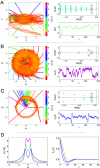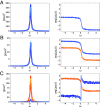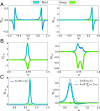A universal description of stochastic oscillators
- PMID: 37432992
- PMCID: PMC10629544
- DOI: 10.1073/pnas.2303222120
A universal description of stochastic oscillators
Abstract
Many systems in physics, chemistry, and biology exhibit oscillations with a pronounced random component. Such stochastic oscillations can emerge via different mechanisms, for example, linear dynamics of a stable focus with fluctuations, limit-cycle systems perturbed by noise, or excitable systems in which random inputs lead to a train of pulses. Despite their diverse origins, the phenomenology of random oscillations can be strikingly similar. Here, we introduce a nonlinear transformation of stochastic oscillators to a complex-valued function [Formula: see text](x) that greatly simplifies and unifies the mathematical description of the oscillator's spontaneous activity, its response to an external time-dependent perturbation, and the correlation statistics of different oscillators that are weakly coupled. The function [Formula: see text] (x) is the eigenfunction of the Kolmogorov backward operator with the least negative (but nonvanishing) eigenvalue λ1 = μ1 + iω1. The resulting power spectrum of the complex-valued function is exactly given by a Lorentz spectrum with peak frequency ω1 and half-width μ1; its susceptibility with respect to a weak external forcing is given by a simple one-pole filter, centered around ω1; and the cross-spectrum between two coupled oscillators can be easily expressed by a combination of the spontaneous power spectra of the uncoupled systems and their susceptibilities. Our approach makes qualitatively different stochastic oscillators comparable, provides simple characteristics for the coherence of the random oscillation, and gives a framework for the description of weakly coupled oscillators.
Keywords: cross-correlation of coupled oscillators; linear response; nonlinear stochastic differential equations; power spectrum.
Conflict of interest statement
The authors declare no competing interest.
Figures






References
-
- Lugo C. A., McKane A. J., Quasicycles in a spatial predator–prey model. Phys. Rev. E 78, 051911 (2008). - PubMed
-
- Rubin J. E., Earn D. J., Greenwood P. E., Parsons T. L., Abbott K. C., Irregular population cycles driven by environmental stochasticity and saddle crawlbys. Oikos 2023, e09290 (2023).
-
- Dubbeldam J. L. A., Krauskopf B., Lenstra D., Excitability and coherence resonance in lasers with saturable absorber. Phys. Rev. E 60, 6580 (1999). - PubMed
-
- García-Ojalvo J., Casademont J., Torrent M. C., Coherence and synchronization in diode-laser arrays with delayed global coupling. Int. J. Bifurcat. Chaos 9, 2225 (1999).
Grants and funding
LinkOut - more resources
Full Text Sources
Research Materials

